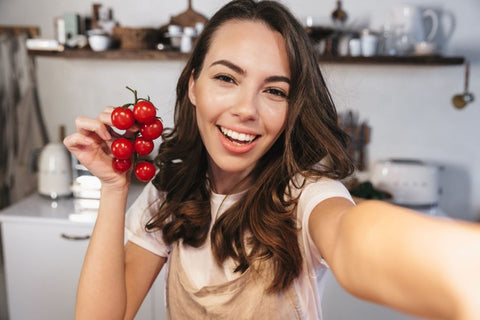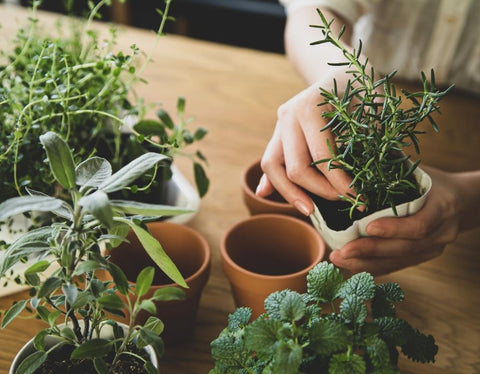So you’ve decided to grow an indoor garden. That’s awesome. But as you’ve probably already realized there are a ton of different ways to go about it, and dozens of different choices to make around how and what to grow.
You have some important decisions to make at this stage, and although it may be tempting to just jump into it and get started immediately, a little bit of planning can save you from making unnecessary mistakes down the road.
A small amount of research up front can drastically improve your chances of success, so if that’s what you’re trying to do then you’re in the right place!
Side note: in addition to this blog you should also download a copy of our free eBook while you’re here. It contains how-to guides for all the most common edible plants you can grow at home and is a great resource to keep handy for future reference. Get your free copy below.
What is Edible Indoor Gardening?
Before we explain the process of starting your Edible Indoor Garden, it’s important to understand how this differs from other types of gardening:
- EDIBLE gardening means that we’re talking about food. Edible plants tend to grow much quicker than non-edible (decorative) plants, and therefore they need much more light. Light requirements for edible plants can be 5-10x higher compared to non-edible plants. More on this below.
- INDOOR gardening means that we’re not doing this outside. This has a few important implications. 1) we’re likely to have less space, so space optimization is important, 2) we’re likely to have less light, and 3) we’re less exposed to weather - so it is conceivable that we do this year round, not just in Spring/Summer.
The Fundamentals of Any Garden - And How To Manage Them Indoors
As you may recall from high school biology all plants have some basic requirements that you are going to need to attend to. There are food (nutrients), water and light.
Substrates for Indoor Gardening
A lot of people think that plants need soil to grow. This is not true. What plants do need, however, is something to support their root zone, and a system for delivering water and nutrients to those roots. Yes, soil is one way to provide these things, but it’s not the only way.
Hydroponics refers to a technique for growing plants without soil. It is popular for indoor gardening because it tends to be more space efficient and is less messy.
Benefits of Hydroponic Growing
Now you know that the two main growing methods for indoor gardening are soil and hydroponics, we will now compare these two based from their benefits.
The main benefit of hydroponics is the maintenance they require. All hydroponic grow setups rely on a reservoir of water that has been enriched with nutrients, and the plants are set up in such a way that they can water themselves as and when they need to. Soil, by comparison, requires more work as it relates to watering.
Benefits of Soil-based Growing
On the other hand, soil also has an advantage when compared with hydroponics, and it’s the diversity of plants it can support. Soil can be dry or it can be wet. It can be sandy or it can be peaty. It can be free-draining or it can hold water. There are just a lot more options when it comes to soil, and that means it can grow a much wider range of plants.
To learn more about these two growing methods, you can take a look at this article.
Lighting for Indoor Gardening
The other important variable here is of course light. You have two main options here:
- Natural Light. You will need at least 4-6 hours of direct (unobstructed) natural light per day in order to grow edible plants indoors. Depending on your location, the intensity of the sun can more than halve during winter. Not only that, but your days are also going to be shorter. Also keep in mind that in many high-rise buildings they use films and protective coatings on the glass that are designed to reduce the intensity of the light that gets in.
- Grow lights. Whilst they obviously come at an additional cost (unlike the sun, which is free!) grow lights do offer a bunch of benefits. They provide almost infinite flexibility, and they remove (or at least reduce) your dependency on the seasons and natural light.
If you’d like to learn more about grow lights, we recommend ‘Indoor Gardening Intro blog’.
Step 1: Decide What You Are Going To Grow Indoors
Now you know the basic fundamentals of any garden, we can now move on to the steps you need to know so you can start your own indoor garden.
The first step to starting an indoor garden is to decide on what seeds you’re going to grow indoors. We recommend these herbs as they’re relatively easy to grow and perfect for beginners like you.
- Basil
- Dill
- Mint
- Chives
- Oregano
- Cilantro
Vegetables, on the other hand, often need more space than what is available indoors, but some of them can be grown indoors as well. Keep in mind to always look for the dwarf/compact cultivars, especially for peppers and tomatoes.
- Peppers
- Tomatoes
- Leafy Salad Greens
- Radishes
- Microgreens
If you want to learn more about what plants, herbs, or vegetables to grow for your indoor garden, check out this article.

Step 2: Select Your Pot or Planter
The next step to starting an indoor garden is to select your pot or planter. If you are relatively new to indoor gardening, then we recommend you skip the hydroponics for now and just focus on using soil. It is more forgiving, and cheaper to get started with. You can always revisit hydroponics later, if you wish.
There are tons of pot or planter options, so we hope we can give you some ideas on what features to look for. All in all – it’s pretty simple.
- First, the pot should have adequate drainage.
- Second, the pot should match the size of your plant.
- Additionally, different materials like plastic, wood, terracotta, and fabric have certain advantages and disadvantages that we summarized in this blog.
Step 3: Select A Potting Mix
The third step to starting your indoor garden would be to select or create a potting mix. In this blog, you’ll learn more about how to make your own potting mix as well as some basic knowledge about it. But to summarize, first, let’s understand what is the difference between potting mix and compost:
|
Potting Mix |
Compost |
|
|
How To Make Potting Mix/DIY Potting Mix for Herbs and Vegetables
Now you know the difference between a potting mix and compost, here’s a short list of the ingredients you’ll need to make your own potting mix. To see the full list of ingredients and step-by-step instructions, click here.
|
For Herbs |
For Vegetables |
|
Ingredients
|
Ingredients
|
Step 4: Additional Equipment
Once you’ve got your potting mix, you’ll want to know about the additional equipment that you need to start your indoor garden. Some of them are:
- Shears
- Thermometer/Hygrometer
- Plant stakes
- Re-potting tarps
- Organic granular fertilizer
To learn more about the indoor gardening tool kit essentials, click here.
Step 5: Plant Your Garden In A Warm, But Not Hot Location
The next thing you need to know in starting your indoor garden is temperature. Seeds have a wide range of temperatures, and several common outdoor garden crops usually germinate around 60-80 °F; however, you should always check the seed packet instructions because each plant is different.
For indoor gardening, many seeds will cease to germinate once the temperature hits around 90-95 °F. You need to make sure not to make your indoor garden too warm, especially during the summer.
Step 6: Care and Maintenance
The 6th step in starting an indoor garden is knowing how to care for and maintain your plants.
To care for your indoor plants, it’s important to know that besides light, correct temperature, pots, and soil, plants also need water. Indoor herbs especially should be watered regularly and to not be allowed to dry out, ever. It’s also important to make sure you check the humidity and air circulation around your plants, so that mildew won’t grow.
If you want to learn more about the care and maintenance for each specific indoor plant, check these blogs here. Just type on the search bar, “how to grow (plant name) indoors”.
Step 7: Harvest
Last but not the least, you need to harvest your plants from your indoor garden. With just a couple snips at the right times you can get your indoor plants to continually produce.
You can also check the individual blogs to learn more how to harvest each specific herb or vegetable.
Indoor Garden Ideas For Small Spaces
Now that we’ve went through the whole process of setting up your own indoor garden, here are some more ideas we think are useful in maximizing your space at home:
- Using alternating canopy heights for indoor gardening by placing short, wide plants next to tall, skinny ones, or by using alternative pot/planter heights
- Going vertical by the help of window shelves
You can read more about getting the most out of your small-space indoor garden here.
There you have it. We hope you’re able to get some ideas about starting an indoor garden. If you need a more comprehensive guide about indoor gardening, you may want to have a copy of our ebook, which is all about Edible Indoor Gardening.










There are no comments for this article. Be the first one to leave a message!